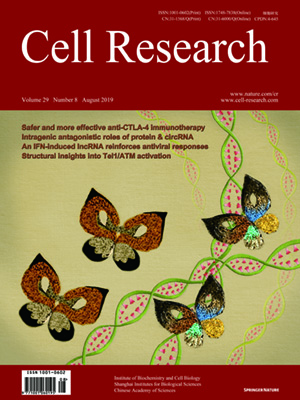
Advanced Search
Submit Manuscript
Advanced Search
Submit Manuscript
Volume 29, No 8, Aug 2019
ISSN: 1001-0602
EISSN: 1748-7838 2018
impact factor 17.848*
(Clarivate Analytics, 2019)
Volume 29 Issue 8, August 2019: 683-685
Jianxiong Xiao 1,2, Mengjie Liu 1,2, Yilun Qi1, Yuriy Chaban3,Chao Gao1, Beiqing Pan1, Yuan Tian1, Zishuo Yu1, Jie Li4,Peijun Zhang 3,5 and Yanhui Xu 1,2,6,7
1 Fudan University Shanghai Cancer Center, Institutes of Biomedical Sciences, State Key Laboratory of Genetic Engineering and Key Laboratory of Medical Epigenetics and Metabolism, Shanghai Medical College of Fudan University, Shanghai 200032, China; 2Key Laboratory of Molecular Medicine, Ministry of Education, Department of Systems Biology for Medicine, School of Basic Medical Sciences, Shanghai Medical College of Fudan University, Shanghai 200032,China; 3Electron Bio-Imaging Centre, Diamond Light Sources, Harwell Science and Innovation Campus, Didcot, Oxfordshire, UK; 4National Facility for Protein Science in Shanghai, Zhangjiang Lab, Shanghai 201210, China; 5Division of Structural Biology, Wellcome Trust Centre for Human Genetics, University of Oxford, Oxford, UK; 6Collaborative Innovation Center of Genetics and Development, School of Life Sciences, Fudan University, Shanghai 200433, China and 7CAS Center for Excellence in Molecular Cell Science, Chinese Academy of Sciences, Shanghai 200031, China
https://doi.org/10.1038/s41422-019-0205-0